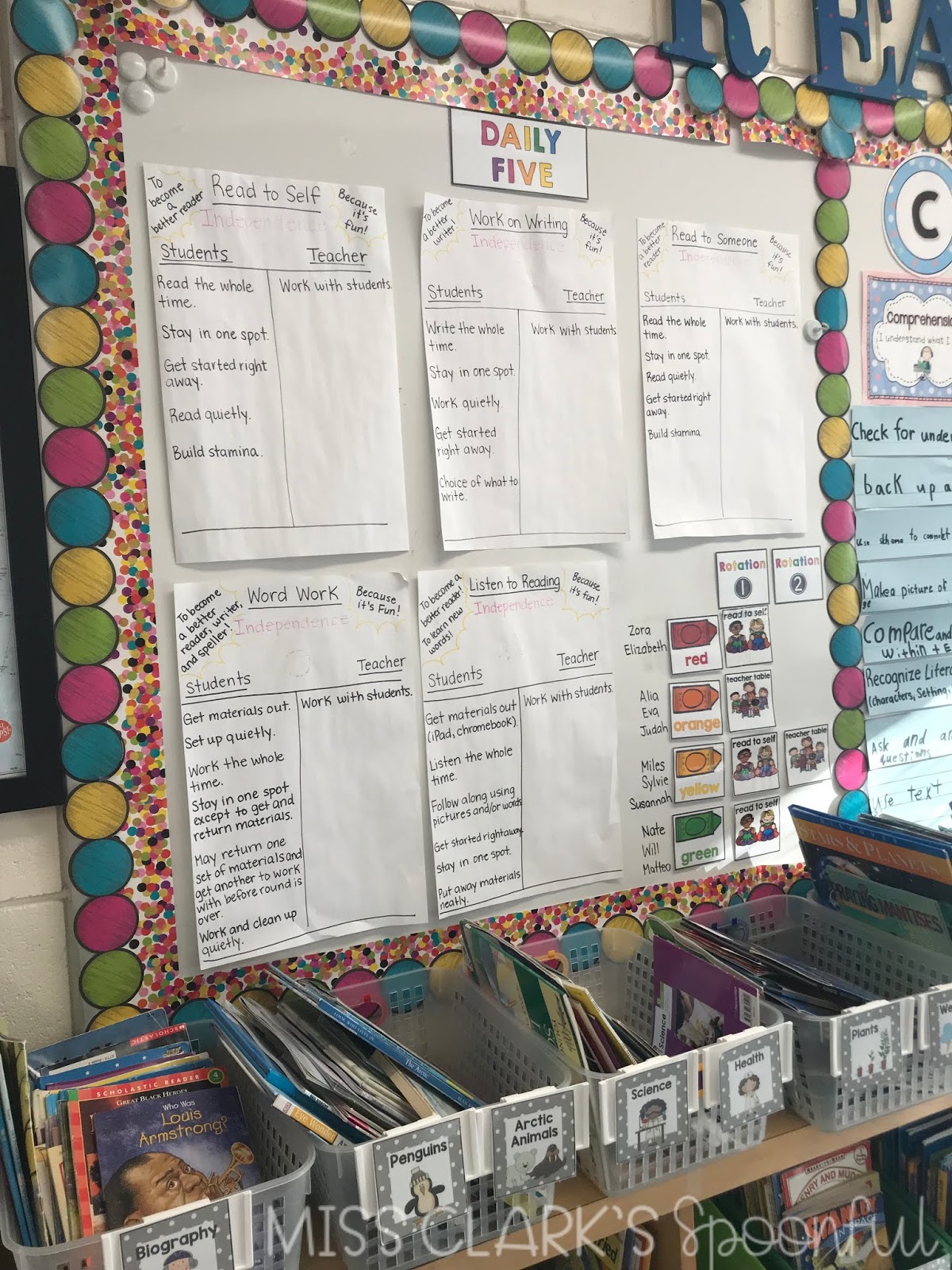95% of our literacy block structure is from The Daily 5. I learned how to teach a balanced literacy block this way as a student teacher, and I immediately fell in love.
Here is what our Daily 5 Board looks like in our classroom! It's right beside the CAFE Board, which displays our reading strategies. True life, people... it's February and the bulletin board border isn't as pristinely staying in place as it was back in September.
You'll notice that at the bottom right corner of the Daily 5 Board, our rotations are listed. The stations the children visit each week are: Teacher Table, Read to Self, Work on Writing, Read to Someone, Word Work, and Listen to Reading.
Now, for the tricky part. My kids have either two or three specials each day. While it makes for incredibly rich learning, it's hard to structure a consistent block of time dedicated to literacy.
Here's how we make our daily rotations work!
10:30 am - 10:40 am: Whole group mini-lesson - The mini-lesson varies! Our school uses Reading Wonders as a resource, so sometimes the mini-lesson will be a comprehension skill/strategy from Wonders. Other times, it will be based on a specific unit (right now, we're in the middle of biographies), or an interactive read aloud involving turn & talks and think alouds. In the beginning of the week, we'll usually cover a phonics skill.
10:40 - 11:00/11:15: Read to Self and Reading Group - I am lucky enough to have an assistant teacher with me all morning. She is THE BEST. In the morning, she will take a reading group while I hold individual conferences with the other students as they Read to Self. While conferencing with the children during Read to Self, I take anecdotal notes on these conferencing sheets. Usually, I'll conference with 3 or 4 children per day.
The work that the children do in reading group varies. Sometimes they'll read a story and answer comprehension questions from the Wonders workbook, or anthology. I'm not a huge fan of strictly teaching whole group from comprehensive literacy programs, and in a small group setting, it's more meaningful. It's also a way to make sure that everyone covers important comprehension skills that week while catering to that group's individual learning styles!
If they're not working out of the workbook, they may be working on the week's phonics or vocabulary skill.
Part of what I like about Wonders is the scope and sequence of vocabulary strategies. The kids enjoy making these mini-books in reading group! You can find them in my TpT shop here!
At 11:00 (or 11:15, depending on the day), the kids are off to specials. Then, we have lunch from 12:30 - 1:00, and afternoon recess from 1:00 - 1:30. On Tuesdays, Thursdays, and Fridays, the kids have another special from 1:30 - 2:00. Mondays and Wednesdays, we're back in the classroom at 1:30. Whether it is 1:30 or 2:00, this is when we resume the literacy block!
Rotation 2:
1:30 pm - 1:40 pm/2:00 pm - 2:10 pm: Whole group mini-lesson - Again, the mini-lesson will vary! In the afternoon, I usually like to keep things reading comprehension strategy focused and pair the mini-lesson with an interactive read aloud.
1:40 pm - 2:20 pm/2:10 pm - 2:30 pm: CHOICE! While I am meeting with one group at the Teacher Table, the other students choose to visit either Read to Someone, Work on Writing, Word Work, or Listen to Reading. Of course, all of these stations were slooooooowly introduced, modeled, and practiced in the beginning of the year before everything was up and running independently.
I keep track of who goes where with this tracking sheet! The students are allowed to visit the same station more than once during the week, as long as it's not two days in a row.

The students also keep track of their own progress. This darling freebie was from Martha over at Primary Paradise on TpT! On the first day of the week, the kids each get a blank rainbow tracking sheet. Each time they visit a station, they color in the corresponding place on the rainbow!
I've found that this tool inspired students to branch out and do less repeating of stations. They're SUPER motivated to fill in all five colors.
Throughout the week, the kids keep all of their work from Daily 5 in a folder. At the end of the week, I'll collect the work from each student's Daily 5 folder, and staple it all together with the tracking sheet on the front. I usually won't meet with a reading group for Rotation 2 on Friday afternoons. Everyone has a choice of their Daily 5 station.
This is when I'll collect each student's work from the week and put it together. As students are working in their choice station, I'll call them over to go over their work from the week. We celebrate new stations that were visited, progress on a certain skill, and correct work when needed. After this brief conference, they color in the last place on the rainbow, the teacher check. Everything gets sent home at the end of the week. It's nice for parents to see exactly what their kiddos have done throughout the week during Daily 5!
Well, that's what a week of Daily 5 in our classroom looks like (in a nutshell).
For my fellow Daily 5 friends, I uploaded my Daily 5 Tracking Sheet to TpT, for FREE! You can download it here or by clicking the picture below.














No comments